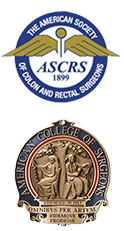Pilonidal Disease
Pilonidal disease refers to a subcutaneous, chronic, often relapsing, infection of the skin and underlying tissue usually occurring just above the crease between the buttocks. It often first presents as a painful swelling that may drain pus spontaneously or as a result of a formal incision and drainage procedure (i.e. acute abscess). Due to the underlying disease, the abscess will often recur and is resistant to permanent healing.
What causes pilonidal disease?
The condition results from a reaction to hairs embedded beneath the skin (pilo meaning “hair” and nidus meaning “nest”). A sinus tract or tunnel beneath the skin allows loose hair shafts to enter small openings, “midline pits”, and form a nest of hairs beneath the skin. It is this area that is prone to infection and gives rise to recurring abscesses. The disease is more common in men than women and frequently occurs between puberty and age 40, usually in those with thick body hair.
What are the symptoms of pilonidal disease?
Symptoms vary from an asymptomatic, small cyst to a large, painful mass. Nearly all patients have an episode of an acute abscess (the area becomes infected, swollen, tender, and may drain pus). After the abscess resolves, either by itself or with medical assistance, the underlying pilonidal sinus remains. Although a few of these sinus tracts may resolve without therapy, most patients will require an operation to treat them.
How is pilonidal disease treated?
Several surgical treatments exist and the most appropriate intervention is based on the complexity of disease. An acute abscess is managed with an incision and drained to release the pus, and reduce the inflammation and pain. This procedure usually can be performed in the office with local anesthesia. Once the acute infection has cleared, the underlying sinus will need to be excised or surgically opened. Procedures vary from simply unroofing the area to excision with or without creating skin flaps to cover the area with adjacent healthy tissue. Larger operations require longer healing times. If the wound is left open, it will require dressing or packing to keep it clean. Although it may take several weeks to heal, the success rate with open wounds is higher. Closure with flaps is a bigger operation that has a higher chance of infection; however, it may be required in some patients. Your surgeon will discuss these options with you and help you select the appropriate operation.
What is the prognosis after surgery?
If the wound can be closed, it will need to be kept clean and dry until the skin is completely healed. If the wound is left open, a wound dressing or packing will be needed to help remove secretions and to allow the wound to heal from the deepest layers up to the skin. After healing, it remains important to keep the area free of hair, with regular hair removal every week (this can often be discontinued as the hair shafts thin after the age of 30.





